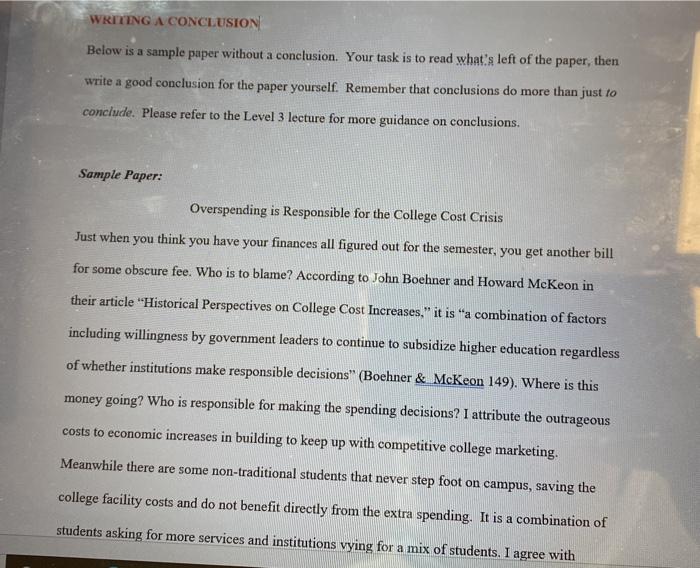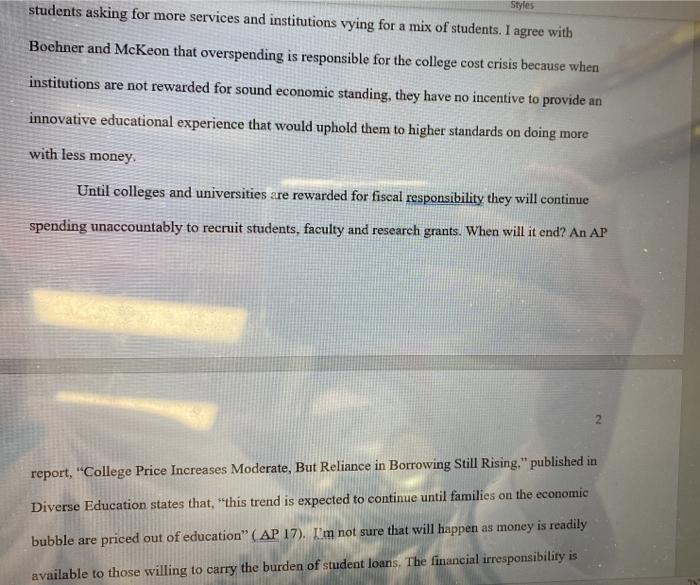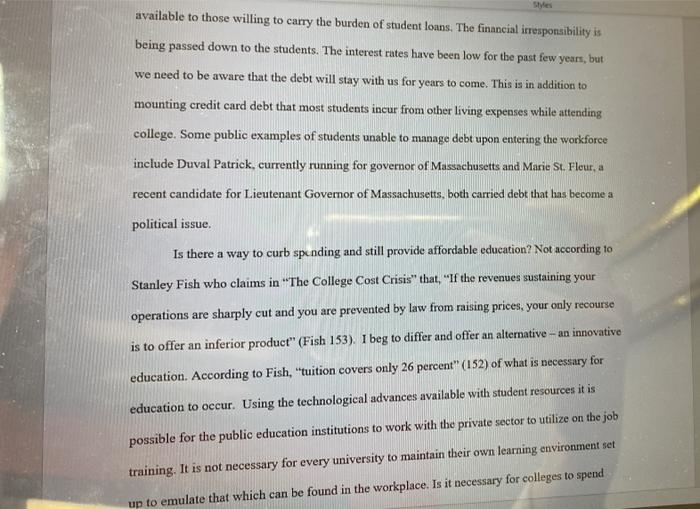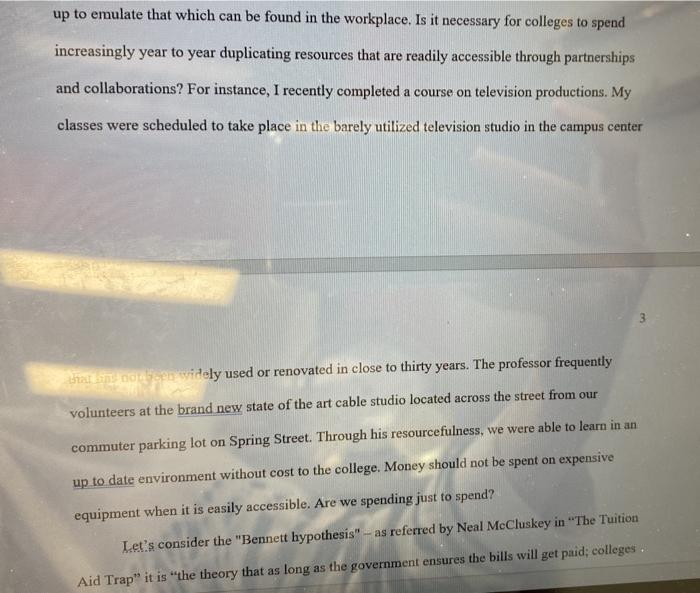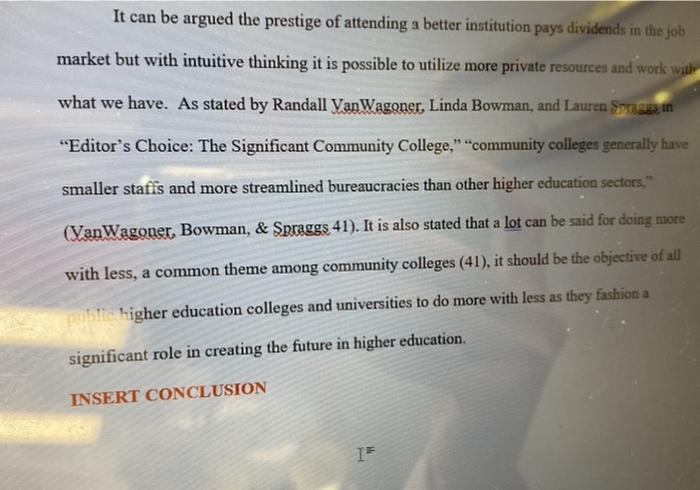WRITING A CONCLUSION Below is a sample paper without a conclusion. Your task is to read what's left of the paper, then write a good conclusion for the paper yourself. Remember that conclusions do more than just to conclude. Please refer to the Level 3 lecture for more guidance on conclusions. Sample Paper: Overspending is Responsible for the College Cost Crisis Just when you think you have your finances all figured out for the semester, you get another bill for some obscure fee. Who is to blame? According to John Bochner and Howard McKeon in their article "Historical Perspectives on College Cost Increases," it is a combination of factors including willingness by government leaders to continue to subsidize higher education regardless of whether institutions make responsible decisions" (Boehner & McKeon 149). Where is this money going? Who is responsible for making the spending decisions? I attribute the outrageous costs to economic increases in building to keep up with competitive college marketing. Meanwhile there are some non-traditional students that never step foot on campus, saving the college facility costs and do not benefit directly from the extra spending. It is a combination of students asking for more services and institutions vying for a mix of students. I agree with students asking for more services and institutions vying for a mix of students. I agree with Styles Boehner and McKeon that overspending is responsible for the college cost crisis because when institutions are not rewarded for sound economic standing, they have no incentive to provide an innovative educational experience that would uphold them to higher standards on doing more with less money Until colleges and universities are rewarded for fiscal responsibility they will continue spending unaccountably to recruit students, faculty and research grants. When will it end? An AP report, "College Price Increases Moderate, But Reliance in Borrowing Still Rising," published in Diverse Education states that, this trend is expected to continue until families on the economic bubble are priced out of education" (AP 17). I'm not sure that will happen as money is readily available to those willing to carry the burden of student loans. The financial irresponsibility is available to those willing to carry the burden of student loans. The financial irresponsibility is being passed down to the students. The interest rates have been low for the past few years, but we need to be aware that the debt will stay with us for years to come. This is in addition to mounting credit card debt that most students incur from other living expenses while attending college. Some public examples of students unable to manage debt upon entering the workforce include Duval Patrick, currently running for governor of Massachusetts and Marie St. Flour, a recent candidate for Lieutenant Governor of Massachusetts, both carried debt that has become a political issue. Is there a way to curb spending and still provide affordable education? Not according to Stanley Fish who claims in "The College Cost Crisis" that, "If the revenues sustaining your operations are sharply cut and you are prevented by law from raising prices, your only recourse is to offer an inferior product" (Fish 153). I beg to differ and offer an alternative - an innovative education. According to Fish, tuition covers only 26 percent" (152) of what is necessary for education to occur. Using the technological advances available with student resources it is possible for the public education institutions to work with the private sector to utilize on the job training. It is not necessary for every university to maintain their own learning environment set up to emulate that which can be found in the workplace. Is it necessary for colleges to spend Aid Trap" it is the theory that as long as the government ensures the bills will get paid, colleges will raise tuition" (http://www.cato.org/cgi-bin/scripts/printtech.cgi/dailys/10-09-03.html). This brings us back to our concern, is the problem caused by overspending? Think of it, there is always a construction crew working on any number of projects on a college campus to accommodate the aesthetic needs of perspective students. This reckless spending is being financed with funds that could go towards lowering tuition costs. Public higher education institutions should not be forced to compete with the spending from private institutions. According to Donald Basch in "Endowment Spending - A Double Edged Sword," "private Colorities tend to have higher reliance on endowment support to fund current operations CE endowment funds are not found in public institutions. We want our public colleges and universities to offer quality affordable education and we need to accept the differences between public and private education. We cannot expect our public institutions to flect the values and aspirations of private institutions As noted by Donald Guskert and Jeri King in their article "The High Cost of Building a Better University." "The facilities we construct reflect the values and aspirations of our institutions" (Guskert & King 24) and "The attractive appearance of the grounds and buildings comes at a cost" (25). All these extras costs are reflected through tuition increases. As long as the government is pumping Styles the money to the schools, the schools will continue to spend it and more to justify the values that they want to portray. I feel that we the students unjustly carry the burden of overspending. We do not have a say other than choosing community college vs. state vs. private. Like any other choice we make it sends a message as to what we value. Although I appreciate all that my campus community offers, I do not take advantage of most of what is offered. I can only hope it is appreciated by others in the community. I would be content to go for the no frills package, looking for the meat and bones of an education, without all the extras. It is wonderful that a college can offer state of Hello toalerts complex that compares with many of the best around and labs for most every department on a campus with buildings from a variety of architectural perspectives. Does the reputation reap financial rewards? Tt can be argued the prestige of attending a better institution pays dividends in the job market but will inclinking it is possible to utilize more private resources and work with what we have. As stated by Randall VanWagoner, Linda Bowman, and Lauren Spraggs in "Editor's Choice: The Significant Community College." "community colleges generally have smaller staffs and more streamlined bureaucracies than other higher education sectors." (Van Wagoner. Bowman, & Spraggs 41). It is also stated that a lot can be said for doing more FOC It can be argued the prestige of attending a better institution pays dividends in the job market but with intuitive thinking it is possible to utilize more private resources and work with what we have. As stated by Randall VanWagoner, Linda Bowman, and Lauren Sproses in "Editor's Choice: The Significant Community College," "community colleges generally have smaller staffs and more streamlined bureaucracies than other higher education sectors," (YanWagoner, Bowman, & Spraggs 41). It is also stated that a lot can be said for doing more with less, a common theme among community colleges (41), it should be the objective of all pub higher education colleges and universities to do more with less as they fashion a significant role in creating the future in higher education. INSERT CONCLUSION I INSERT CONCLUSION WRITING A CONCLUSION Below is a sample paper without a conclusion. Your task is to read what's left of the paper, then write a good conclusion for the paper yourself. Remember that conclusions do more than just to conclude. Please refer to the Level 3 lecture for more guidance on conclusions. Sample Paper: Overspending is Responsible for the College Cost Crisis Just when you think you have your finances all figured out for the semester, you get another bill for some obscure fee. Who is to blame? According to John Bochner and Howard McKeon in their article "Historical Perspectives on College Cost Increases," it is a combination of factors including willingness by government leaders to continue to subsidize higher education regardless of whether institutions make responsible decisions" (Boehner & McKeon 149). Where is this money going? Who is responsible for making the spending decisions? I attribute the outrageous costs to economic increases in building to keep up with competitive college marketing. Meanwhile there are some non-traditional students that never step foot on campus, saving the college facility costs and do not benefit directly from the extra spending. It is a combination of students asking for more services and institutions vying for a mix of students. I agree with students asking for more services and institutions vying for a mix of students. I agree with Styles Boehner and McKeon that overspending is responsible for the college cost crisis because when institutions are not rewarded for sound economic standing, they have no incentive to provide an innovative educational experience that would uphold them to higher standards on doing more with less money Until colleges and universities are rewarded for fiscal responsibility they will continue spending unaccountably to recruit students, faculty and research grants. When will it end? An AP report, "College Price Increases Moderate, But Reliance in Borrowing Still Rising," published in Diverse Education states that, this trend is expected to continue until families on the economic bubble are priced out of education" (AP 17). I'm not sure that will happen as money is readily available to those willing to carry the burden of student loans. The financial irresponsibility is available to those willing to carry the burden of student loans. The financial irresponsibility is being passed down to the students. The interest rates have been low for the past few years, but we need to be aware that the debt will stay with us for years to come. This is in addition to mounting credit card debt that most students incur from other living expenses while attending college. Some public examples of students unable to manage debt upon entering the workforce include Duval Patrick, currently running for governor of Massachusetts and Marie St. Flour, a recent candidate for Lieutenant Governor of Massachusetts, both carried debt that has become a political issue. Is there a way to curb spending and still provide affordable education? Not according to Stanley Fish who claims in "The College Cost Crisis" that, "If the revenues sustaining your operations are sharply cut and you are prevented by law from raising prices, your only recourse is to offer an inferior product" (Fish 153). I beg to differ and offer an alternative - an innovative education. According to Fish, tuition covers only 26 percent" (152) of what is necessary for education to occur. Using the technological advances available with student resources it is possible for the public education institutions to work with the private sector to utilize on the job training. It is not necessary for every university to maintain their own learning environment set up to emulate that which can be found in the workplace. Is it necessary for colleges to spend Aid Trap" it is the theory that as long as the government ensures the bills will get paid, colleges will raise tuition" (http://www.cato.org/cgi-bin/scripts/printtech.cgi/dailys/10-09-03.html). This brings us back to our concern, is the problem caused by overspending? Think of it, there is always a construction crew working on any number of projects on a college campus to accommodate the aesthetic needs of perspective students. This reckless spending is being financed with funds that could go towards lowering tuition costs. Public higher education institutions should not be forced to compete with the spending from private institutions. According to Donald Basch in "Endowment Spending - A Double Edged Sword," "private Colorities tend to have higher reliance on endowment support to fund current operations CE endowment funds are not found in public institutions. We want our public colleges and universities to offer quality affordable education and we need to accept the differences between public and private education. We cannot expect our public institutions to flect the values and aspirations of private institutions As noted by Donald Guskert and Jeri King in their article "The High Cost of Building a Better University." "The facilities we construct reflect the values and aspirations of our institutions" (Guskert & King 24) and "The attractive appearance of the grounds and buildings comes at a cost" (25). All these extras costs are reflected through tuition increases. As long as the government is pumping Styles the money to the schools, the schools will continue to spend it and more to justify the values that they want to portray. I feel that we the students unjustly carry the burden of overspending. We do not have a say other than choosing community college vs. state vs. private. Like any other choice we make it sends a message as to what we value. Although I appreciate all that my campus community offers, I do not take advantage of most of what is offered. I can only hope it is appreciated by others in the community. I would be content to go for the no frills package, looking for the meat and bones of an education, without all the extras. It is wonderful that a college can offer state of Hello toalerts complex that compares with many of the best around and labs for most every department on a campus with buildings from a variety of architectural perspectives. Does the reputation reap financial rewards? Tt can be argued the prestige of attending a better institution pays dividends in the job market but will inclinking it is possible to utilize more private resources and work with what we have. As stated by Randall VanWagoner, Linda Bowman, and Lauren Spraggs in "Editor's Choice: The Significant Community College." "community colleges generally have smaller staffs and more streamlined bureaucracies than other higher education sectors." (Van Wagoner. Bowman, & Spraggs 41). It is also stated that a lot can be said for doing more FOC It can be argued the prestige of attending a better institution pays dividends in the job market but with intuitive thinking it is possible to utilize more private resources and work with what we have. As stated by Randall VanWagoner, Linda Bowman, and Lauren Sproses in "Editor's Choice: The Significant Community College," "community colleges generally have smaller staffs and more streamlined bureaucracies than other higher education sectors," (YanWagoner, Bowman, & Spraggs 41). It is also stated that a lot can be said for doing more with less, a common theme among community colleges (41), it should be the objective of all pub higher education colleges and universities to do more with less as they fashion a significant role in creating the future in higher education. INSERT CONCLUSION I INSERT CONCLUSION
